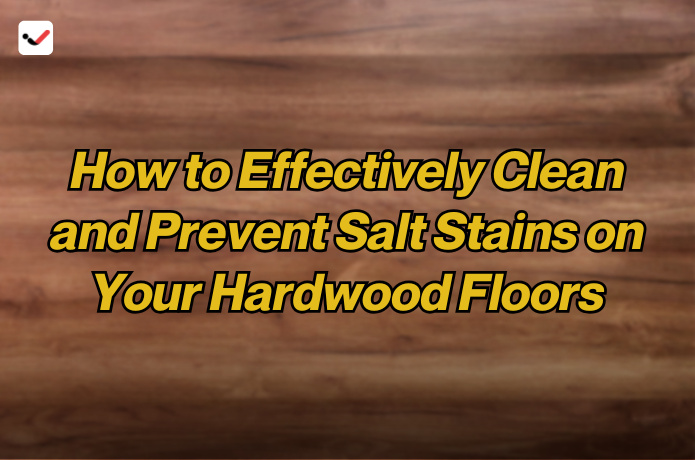How to Effectively Clean and Prevent Salt Stains on Your Hardwood Floors
How to Effectively Clean and Prevent Salt Stains on Your Hardwood Floors

Salt stains on hardwood floors can be a common problem during the winter months, especially in areas where roads and sidewalks are treated with salt to combat snow and ice. While salt helps to keep surfaces safe, it can also leave unsightly and damaging stains on your beautiful hardwood floors. The good news is that with the right cleaning methods and prevention strategies, you can keep your floors looking pristine all year round. In this article, we will explore simple and effective ways to clean salt stains from hardwood floors and provide tips on how to prevent them from forming in the first place.
Hardwood floors are an investment, and proper care is essential to maintain their beauty and longevity. Salt can cause long-term damage if left untreated, as it can cause the finish to wear away, leading to discoloration or even permanent damage to the wood. However, by regularly cleaning the salt and using some preventive measures, you can protect your floors and keep them looking their best. Let’s take a closer look at the best practices for cleaning and preventing salt stains on hardwood floors.
Step 1: Sweep or Vacuum Regularly
The first step in preventing salt stains on hardwood floors is to keep the area clean. Sweeping or vacuuming regularly will help remove salt and other debris that can accumulate on the floor. Salt can be abrasive, and if it’s left on the surface for too long, it can scratch the wood or cause discoloration. Make it a habit to sweep or vacuum your floors daily during the winter months when salt is more likely to accumulate.
Using a vacuum cleaner with a soft brush attachment or a broom with soft bristles will ensure that you don’t scratch the surface of your hardwood floors while removing salt. Be sure to target high-traffic areas, like entryways, hallways, and near doorways, where salt is most likely to be tracked in from outside.
Step 2: Clean Salt Stains Promptly
If you notice salt stains on your hardwood floor, it’s important to clean them promptly to prevent long-term damage. The longer the salt sits on the floor, the harder it becomes to remove. To clean salt stains effectively, you’ll need a mild cleaning solution. Mix a few drops of dish soap or a gentle hardwood floor cleaner with warm water in a bucket.
Damp a soft cloth or microfiber mop in the cleaning solution, then wring it out so it’s not dripping wet. Gently wipe the salt stains, making sure not to soak the wood. Excess moisture can damage the wood or cause it to warp. After cleaning, wipe the area with a dry towel to remove any remaining moisture.
Step 3: Use Vinegar for Stubborn Stains
If salt stains are more stubborn and won’t come off with a mild cleaning solution, you can try using vinegar. Vinegar is a natural cleaner that can help break down salt and other minerals. Mix a solution of one part vinegar to ten parts water, and apply it to the stained area with a soft cloth. Allow it to sit for a few minutes, then gently scrub the stain. Be sure to dry the area thoroughly after cleaning to prevent any moisture damage.
It’s important to test this solution on a small, inconspicuous area of the floor first to ensure that the vinegar won’t damage the finish of your hardwood floor. Vinegar can be effective for stubborn stains, but you should always use it cautiously.
Step 4: Use a Wood Floor Cleaner for Extra Protection
Once the salt stains have been cleaned, consider using a specialized wood floor cleaner to add an extra layer of protection. Many wood floor cleaners not only clean the surface but also help to restore the shine and protect the wood from future damage. Some cleaners even provide a protective coating that can help resist stains and moisture.
Be sure to choose a cleaner that’s safe for hardwood floors and follow the manufacturer's instructions for application. Avoid using harsh chemicals or abrasive cleaners, as these can damage the wood over time.
Step 5: Seal Your Hardwood Floors
To prevent salt from seeping into your hardwood floors and causing permanent damage, it’s a good idea to apply a protective sealant. A quality hardwood floor sealant can help to form a barrier against moisture, dirt, and salt. By sealing your floors, you can make them easier to clean and prevent the salt from causing stains in the future.
Sealing your floors is typically done after they’ve been cleaned and refinished. If you’re unsure about how to seal your hardwood floors, consider hiring a professional to ensure the job is done correctly. Keep in mind that hardwood floors may need to be resealed every few years, depending on the level of wear and tear they experience.
Step 6: Place Mats or Rugs Near Entryways
An effective way to prevent salt from reaching your hardwood floors is by placing mats or rugs near entryways. These mats will trap salt, dirt, and moisture before they can be tracked onto your floors. Choose rugs with a rubber backing to prevent moisture from seeping through and damaging the wood. Be sure to clean the mats regularly to remove any accumulated salt and debris.
Additionally, consider using outdoor mats to help remove salt and dirt from shoes before they enter the home. This simple step can significantly reduce the amount of salt that reaches your hardwood floors, making it easier to maintain their condition.
Step 7: Consider Floor Protectors for High-Traffic Areas
If you live in an area where salt use is heavy, you might want to consider installing floor protectors in high-traffic areas. These protective covers can be placed near entryways or other frequently used areas to shield the wood from salt and moisture. Floor protectors come in various forms, including adhesive pads, plastic covers, and custom floor mats.
These protectors are particularly useful in areas like the front door, where salt and snow are often tracked in. By using floor protectors, you can prevent salt from coming into direct contact with your hardwood floors, thereby reducing the risk of stains and damage.
Salt stains on hardwood floors can be a frustrating issue, but with the right cleaning techniques and preventive measures, you can protect your floors and keep them looking beautiful. Regular sweeping, prompt cleaning of stains, and the use of protective coatings can help maintain the appearance of your hardwood floors during the winter months. By adding mats near entryways, sealing your floors, and using floor protectors, you can reduce the risk of salt damage and extend the life of your floors. With these simple steps, you can enjoy the beauty of your hardwood floors without worrying about the effects of salt stains.

